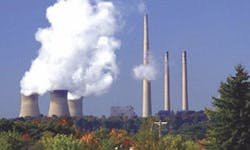Pennsylvania Power Plant Installs New Filters
Homer City Power Generation is a three-unit, coal-fired power plant producing 1.884 MW of power and capable of sustaining 2 million households. The facility is owned by Edison International and operated by its subsidiary, Midwest Generation. The 40-year-old plant is located in Indiana County in Western Pennsylvania and incorporates the tallest smokestack in the United States (1217 feet).
In July 2005, a Fuzzy Filter presentation was made to EME Homer City Generation for possible application of the removal of coal particles from storm water. This application was not pursued, but Homer City was impressed with the Fuzzy Filter technology. In March 2008, another Fuzzy Filter application surfaced at the Homer City plant; it involved the replacement of four existing potable water sand filters. These filters polished effluent from the river water clarifier prior to passing it through reverse osmosis (RO) systems. RO product water is then provided to the power boilers and other potable water users. Fuzzy Filter pilot testing was initiated in early June 2008. Three weeks of pilot testing demonstrated that the pilot Fuzzy Filter removed more than double the turbidity of the existing sand filters. During testing, typical influent turbidities were 0.30 NTU, and effluent turbidities averaged 0.08 NTU. The Fuzzy Filter system also offered total automatic operation; the manual sand filters required regular operator attention.
After review of the Schreiber formal pilot testing report and a field visit to the Schreiber Fuzzy Filter installation at the Logan–Todd Water Treatment Plant in Guthrie, Ky., two 6-ft-by-6-ft stainless steel filters were purchased in October 2008. This was the first Fuzzy Filter installation in a pre-RO application. Total redundancy is provided with a system design flow of 1200 gpm. Influent flow control is provided by magnetic flow meters for each filter and modulating influent valves. Filter effluent is discharged into two existing basins under the concrete floor of the filter building. Influent flow is controlled to maintain a level set point in the basins, which is dictated by the requirements of the RO systems. This control logic was incorporated into the Fuzzy Filters’ main control panel and field-tuned during start-up.
The two 6-ft-by-6-ft Fuzzy Filters replaced four much larger sand filters in less than half the floor space. Two of the sand filters were demolished to provide room to install the Fuzzy Filters. Logistics necessitated installing and starting up one Fuzzy Filter at a time while sand filters continued operation. The first Fuzzy Filter began operation in August 2009, and the second began operation in October 2009. The Fuzzy Filters provide improved water quality for the RO system, automated filter operation, automated water inventory control and increased floor space in the congested potable water filter building.
